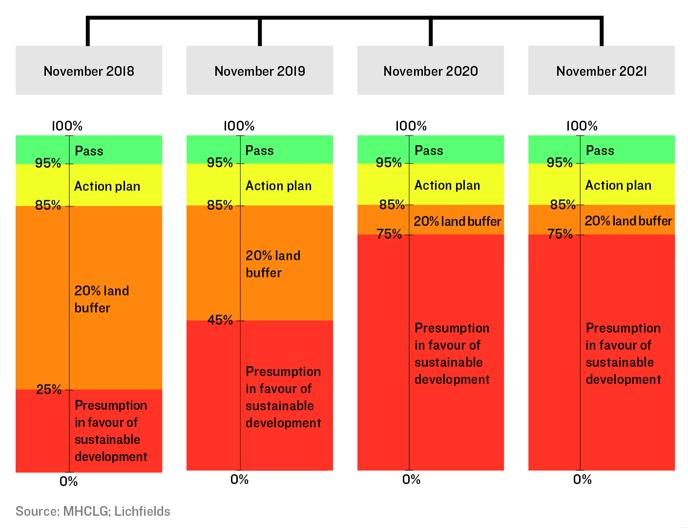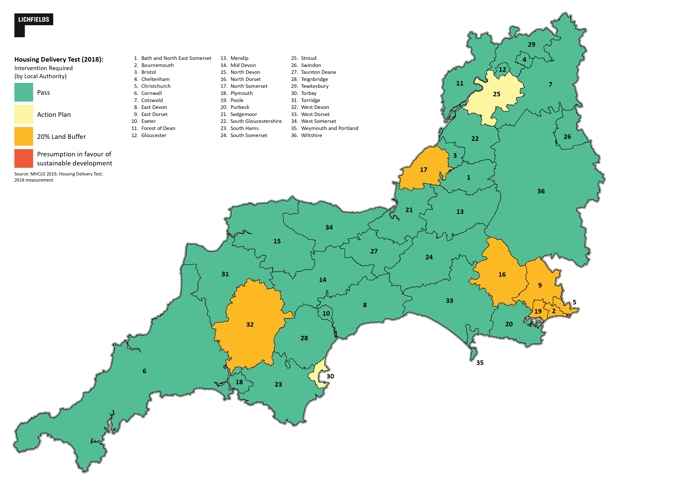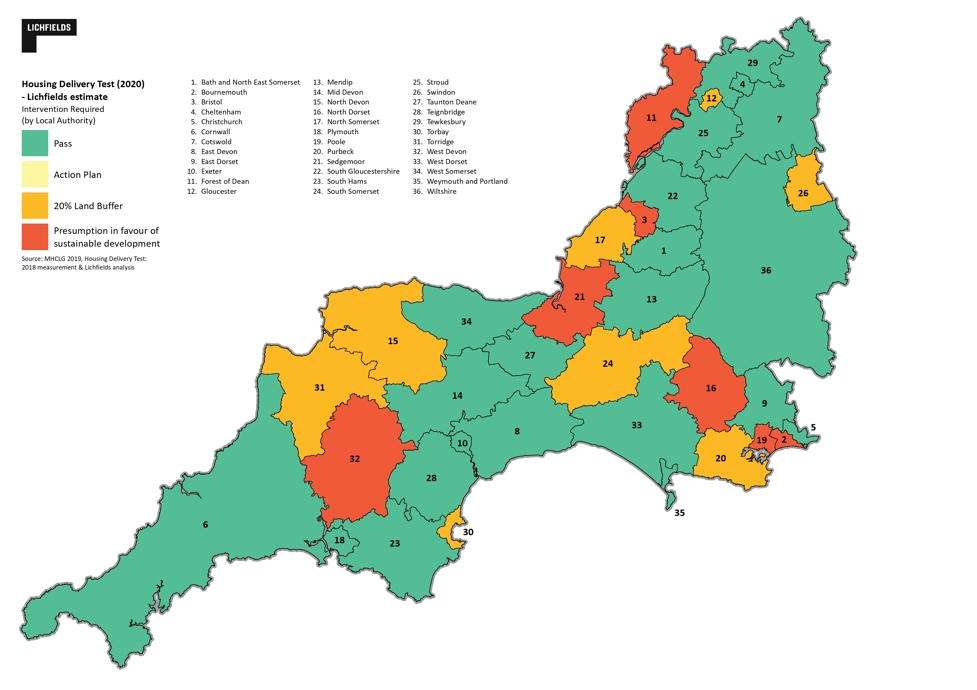Last February, the Ministry of Housing, Communities and Local Government (MHCLG) published the results of the new Housing Delivery Test (HDT), for each local authority in England. Whilst the objectives and methodology of the HDT are now well known, it is helpful to consider the implications of these results and to assess how the situation might change as the thresholds for the various sanctions increase, firstly in November 2019 and again in November 2020.
Figure 1: Housing Delivery Test Methodology

Source: MHCLG; Lichfields
Looking nationally, the results of the HDT as they apply from February 2019 show:
1. 7% of councils will be required to produce an action plan;
2. 27% of councils will need to apply a 20% buffer to their housing land supply;
3. 66% of councils will be required to take no action at all; and,
4. Crucially, no councils will immediately be subject to the presumption in favour of sustainable development.
Figure 1 shows that within the South West region:
1. Both Stroud District Council and Torbay Council, which equates to 6% of all the South West authorities, will be required to produce an action plan;
2. 19% of councils will need to apply a 20% buffer to their housing land supply. These councils include:
a. North Somerset Council
b. West Devon Borough Council;
c. North Dorset District Council;
d. East Dorset District Council;
e. Christchurch Borough Council;
f. Borough of Poole Council; and,
g. Bournemouth Borough Council; and,
3. 75% of councils will be required to take no action at all.
Figure 2: Housing Delivery Test 2018

Source: Lichfields (2019)
The results therefore indicate that the South West region is over performing when compared to the national results, highlighting a relatively higher housing delivery over the past 3 years.
If past delivery continues at the same rate as per the last 3 years, our estimates for the HDT show that, from November 2020, a third of councils nationally are likely to face the presumption in favour of sustainable development.
Our estimates also show that within the South West region:
1. 19% of councils will be subject to the presumption in favour of sustainable development. These councils include:
a. Forest of Dean District Council;
b. Bristol City Council;
c. Sedgemoor District Council;
d. West Devon Borough Council;
e. North Dorset District Council;
f. Borough of Poole Council; and,
g. Bournemouth Borough Council.
2. 22% of councils will need to apply a 20% buffer to their housing land supply. These councils include:
a. Purbeck District Council;
b. South Somerset District Council;
c. Swindon Borough Council;
d. Gloucester City Council;
e. North Somerset Council;
f. North Devon Council;
g. Torridge District Council; and,
h. Torbay Council; and,
3. 61% of councils will be required to take no action at all.
Figure 3: Housing Delivery Test 2020

Source: Lichfields (2019)
Again, this shows a relative over-performance in relation to other English regions (especially London, and the South East) and England as a whole. However, it is important to identify those areas within which past delivery rates will need to increase substantially in order to avoid the relevant penalties that our estimates show at Figure 2.
Furthermore, almost two thirds of authorities in the South West are likely to face an increase in housing requirement as a consequence of the application of the standard method to estimate local housing needs (against their existing Local Plan requirement). For the purposes of assessing performance against the HDT, an increase in the future requirement means that it is not just the increasingly severe threshold for the application of sanctions that will cause authorities to fall into the presumption in favour of sustainable development categories.
Although we cannot know how many houses will be delivered in the future and can therefore only estimate future performance against the HDT, this analysis nevertheless is instructive in highlighting those authorities within which a dramatic increase in net completions is necessary going forwards if the most severe sanctions are to be avoided.
Furthermore, the fact that the HDT brings more certainty in relation to the application of a 20% buffer is also likely to have an impact on the other route to the “tilted balance”, which relates to five-year housing land supply. In the context of the tougher approach to deliverability within the revised NPPF, this will require more sites to be identified for future development in a number of authorities. For more information on the approach to the assessment of five-year housing land supply set out in the Revised NPPF, take a look at
our Insight Focus .
In conclusion, the HDT is a key monitoring tool based on previous housing delivery performance. However, the numbers produced are likely to change as the Test will reflect future fluctuations in the data and housing figures, and it will be difficult to precisely estimate housing requirements many years into the future. These estimates show that continuing to monitor changes to housing figures is essential to ensure future housing projections are sufficient and can be met.
To find out more about the HDT and Local Housing Need please follow the link below to our
Insight focus.






